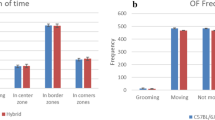Abstract
MHC-congenic mice prefer to mate with mice of different MHC types and are able to discriminate between MHC-congenic mice by their urine odors, but nothing is known about behavioral differences among MHC-congenic mice. The present experiments examine the strain and sex differences in MHC-congenic C57BL/6J and B6-H-2K mice with respect to exploration and fear motivated behaviors in the elevated plus maze, the elevated zero maze, and the open field. In the elevated plus maze and elevated zero maze, C57BL/6J mice spent more time in the open areas than B6-H-2K mice, suggesting that they were less fearful and more exploratory. No sex differences for exploration were found but male mice defecated more than females in the elevated plus maze. In the open field there were no significant strain or sex differences in measures of exploration or fear. There were no strain differences in the investigation of a novel object placed into the open field, but males investigated the novel object more than females. These results indicate that there are differences in exploratory and fear behavior in MHC-congenic mice that may contribute to mate preferences and that behavioral differences in these mice might be further examined advantageously.
Similar content being viewed by others
REFERENCES
Apanius, V., Penn, D., Slev, P. R., Ruff, L. R., and Potts, W. K. (1997). The nature of selection on the major histocompatibility complex. Crit. Rev. Immunol. 17:179-224.
Archer, J. (1973). Tests for emotionality in rats and mice. A review. Anim. Behav. 21:205-235.
Beauchamp, G. K., Yamazaki, K., Wysocki, C. J., Slotnick, B. M., Thomas, L., and Boyse, E. A. (1985). Chemosensory recognition of mouse major histocompatibility types by another species. Proc. Natl. Acad. Sci. USA 82:4186-4188.
Brown, R. E., Schellinck, H. M., and Jagosh, J. (1999). Behavioural studies of MHC-congenic mice. Genetica 104:249-257.
Eklund, A. C. (1999). Use of the MHC for mate choice in wild house mice (Mus domesticus). Genetica 104:245-248.
Fox, R. R., and Witham, B. A. (eds.). Handbook on Genetically Standardized JAX Mice, Jackson Laboratory, Bar Harbor, MA.
Ivanyi, P. (1978). Some aspects of the H-2 system, the major histocompatibility system in the mouse. Proc. Roy. Soc. London Ser. B 202:117-158.
Klein, J. (1986). Natural History of the Major Histocompatibility Complex, Wiley, New York.
Lee, C., and Rodgers, R. J. (1990). Antinociceptive effects of elevated plus-maze exposure: Influence of opiate receptor manipulations. Psychopharmacology 102:507-513.
Lister, R. G. (1987). The use of a plus-maze to measure anxiety in the mouse. Psychopharmacology 92:180-185.
Manning, C. J., Wakeland, E. K., and Potts, W. K. (1992). Communal nesting patterns in mice implicate MHC genes in kin recognition. Nature 360:581-583.
Mathis, C., Paul, S. M., and Crawley, J. N. (1994). Characterization of benzodiazepine-sensitive behaviors in the A/J and C57BL/6J inbred strains of mice. Behav. Genet. 24:171-180.
Maxson, S. C. (1992). MHC genes, chemosignals, and genetic analyses of murine social behaviors. In Doty, R. L., and Muller-Schwarze, D. (eds.), Chemical Signals in Vertebrates VI, Plenum Press, New York, pp. 197-204.
Ninomiya, K., and Brown, R. E. (1995). Removal of the preputial glands alters the individual odors of male MHC-congenic mice and the preferences of females for these odors. Physiol. Behav. 58:191-194.
Potts, W. K., Manning, C. J., and Wakeland, E. K. (1991). Mating patterns in seminatural populations of mice influenced by MHC genotype. Nature 352:619-621.
Rodgers, R. J. (1997). Animal models of “anxiety”: Where next? Behav. Pharmacol. 8:477-496.
Rodgers, R. J., and Cole, J. C. (1993). Anxiety enhancement in the murine elevated plus maze by immediate prior exposure to social stressors. Physiol. Behav. 53:383-388.
Rodgers, R. J., Lee, C., and Shepherd, J. K. (1993). Influence of prior maze experience on behavior and response to diazepam in the elevated plus-maze and light/dark tests of anxiety in mice. Psychopharmacology 113:237-242.
Shepherd, J. K., Grewal, S. S., Fletcher, A., Bill, D. J., and Dourish, C. T. (1994). Behavioral and pharmacological characterization of the elevated “zero maze” as an animal model of anxiety. Psychopharmacology 116:56-64.
Streng, J. (1974). Exploration and learning behavior in mice selectively bred for high and low levels of activity. Behav. Genet. 4:191-204.
Trullas, R., and Skolnick, P. (1993). Differences in fear motivated behaviors among inbred mouse strains. Psychopharmacology 111:323-331.
Weiss, E., and Greenberg, G. (1996). Open field procedures. In Greenberg, G., and Haraway, M. H. (eds.), Comparative Psychology: A Handbook, Garland, New York, pp. 603-62.
Yamaguchi, M., Yamazaki, K., Beauchamp, G. K., Bard, J., Thomas, L., and Boyse, E. A. (1981). Distinctive urinary odors governed by the major histocompatibility locus of the mouse. Immunology 78:5817-5820.
Yamazaki, K., Boyse, E. A., Mike, V., Thaler, H. T., Mathieson, B. J., Abbott, J., Boyse, E., Zayas, Z. A., and Thomas, L. (1976). Control of mating preferences in mice by genes in the major histocompatibility complex. J. Exp. Med. 144:1324-1335.
Yamazaki, K., Beauchamp, G. K., Kupniewski, D., Bard, J., Thomas, L., and Boyse, E. A. (1988). Familial imprinting determines H-2 selective mating preferences. Science 240:1331-1332.
Yamazaki, K., Singer, A., and Beauchamp, G. K. (1999). Origin, functions and chemistry of H-2 regulated odorants. Genetics 104:235-240.
Author information
Authors and Affiliations
Rights and permissions
About this article
Cite this article
Brown, R.E., Corey, S.C. & Moore, A.K. Differences in Measures of Exploration and Fear in MHC-Congenic C57BL/6J and B6-H-2K Mice. Behav Genet 29, 263–271 (1999). https://doi.org/10.1023/A:1021694307672
Issue Date:
DOI: https://doi.org/10.1023/A:1021694307672




